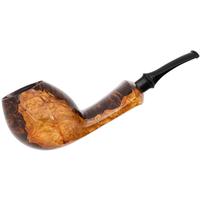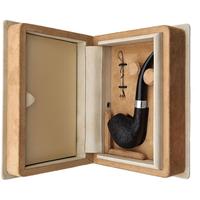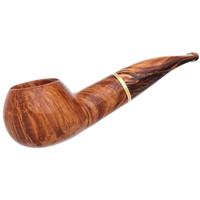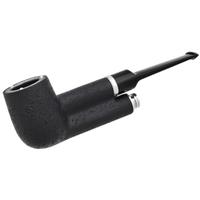Have just ordered some to try. Jojoba was a fail as I will explain in depth later. It appears Fred Bass was right and coloring is enhanced by the migration of wax into and out of the strummel. For this to work the wax used must have a melting temperature above room temperature and below combustion temperature.Hi Jeff, can you try cetyl esters? They are supposedly closer to spermaceti and have similar applications as beeswax.
Messing With Meerschaum
- Thread starter jhowell
- Start date
You are using an out of date browser. It may not display this or other websites correctly.
You should upgrade or use an alternative browser.
You should upgrade or use an alternative browser.
- Status
- Not open for further replies.
Have just ordered some to try. Jojoba was a fail as I will explain in depth later. It appears Fred Bass was right and coloring is enhanced by the migration of wax into and out of the strummel. For this to work the wax used must have a melting temperature above room temperature and below combustion temperature.
Thanks for looking into it.
For your safety, refer to this data sheet: http://phm.utoronto.ca/~ddubins/MSDS/Spermaceti_MSDS.pdf
Cetyl esters melt around 43-47C and are flammable at high temps similar to beeswax, tho it has a much lower melting point. A heat gun on the lowest setting would be more than enough to apply it but if you do the melt and dip, keep an eye on your temp.
I agree with Fred Bass' notes and have an idea on recreating that scenario if you're interested. Please keep the wax uncolored if this is the case.
I'm curious about the jojoba. I thought that would have been a suitable alternative...
Jojoba oil (technically a wax) is liquid at room temperature. When applied to meerschaum is is fully absorbed and wicks into the chamber - heating the strummel only makes it absorbe more and tastes terrible. Taking into account Fred's theory, the coating must be a solid at room temperature and liquefy at smoking temperatures. The heat of smoking liquifies and pulls the wax deep into the strummel and as it cools the wax is drawn back to the surface bringing color with it.Thanks for looking into it.
For your safety, refer to this data sheet: http://phm.utoronto.ca/~ddubins/MSDS/Spermaceti_MSDS.pdf
Cetyl esters melt around 43-47C and are flammable at high temps similar to beeswax, tho it has a much lower melting point. A heat gun on the lowest setting would be more than enough to apply it but if you do the melt and dip, keep an eye on your temp.
I agree with Fred Bass' notes and have an idea on recreating that scenario if you're interested. Please keep the wax uncolored if this is the case.
I'm curious about the jojoba. I thought that would have been a suitable alternative...
I re-read some of the Fred Bass article today, including the ones which were published later in the Reborn Pipes website. I posted a hypothesis a couple of months ago, which was based on observations not done in a very scientific manner. Some long term forum members refuted it, based on their observations, which were also not done in a scientific manner. I read some of the observations you are doing ... I will be posting my hypothesis below, again ... and it would be great if you can prove (or disprove) it.
My hypothesis is this ...
Movement of color in the substrate of Meerschaum happens due to change in capillary forces across a thermal gradient, in presence of a solvent. That is when the meerschaum heats up, the porosity changes minutely across the thermal gradient which in turn changes capillary forces. Even without the presence of a solvent, the coloring agents would migrate (albeit slowly), but the movement is vastly accelerated by the presence of a solvent to the surface. The solvent can be anything, even water.
This explains the couple of behaviors every meerschaum owner has seen:
Beeswax acts as a solvent, but it also acts as a fixer. When the wax cools, it holds the color to the surface, rather than the color moving back inside when the thermal gradient is neutralized (Pipe is fully cooled)
This explains the following observation which many pipe smoker has experienced
1. A moderately smoked Meerschaum when smoked regularly will color to some extent but will start to fade back to white slowly over time. Even if beeswax fixes the color to the surface, it still moves back slowly
Finally when the Meerschaum is smoked a LOT it will completely saturate, and the beeswax would not matter much
Also, a Meerschaum which has been waxed regularly will color more evenly than another pipe, which has been colored only by smoking
Have fun with your experiments!!!
My hypothesis is this ...
Movement of color in the substrate of Meerschaum happens due to change in capillary forces across a thermal gradient, in presence of a solvent. That is when the meerschaum heats up, the porosity changes minutely across the thermal gradient which in turn changes capillary forces. Even without the presence of a solvent, the coloring agents would migrate (albeit slowly), but the movement is vastly accelerated by the presence of a solvent to the surface. The solvent can be anything, even water.
This explains the couple of behaviors every meerschaum owner has seen:
- Moderately smoked Meerschaum which is whitish blooms with color when washed in hot water
- Moderately smoked Meerschaum when smoked and hence hot looks more colorful than the same one when cold.
Beeswax acts as a solvent, but it also acts as a fixer. When the wax cools, it holds the color to the surface, rather than the color moving back inside when the thermal gradient is neutralized (Pipe is fully cooled)
This explains the following observation which many pipe smoker has experienced
1. A moderately smoked Meerschaum when smoked regularly will color to some extent but will start to fade back to white slowly over time. Even if beeswax fixes the color to the surface, it still moves back slowly
Finally when the Meerschaum is smoked a LOT it will completely saturate, and the beeswax would not matter much
Also, a Meerschaum which has been waxed regularly will color more evenly than another pipe, which has been colored only by smoking
Have fun with your experiments!!!
I agree 100% on the capillary action. Aided by the Bernoulli principal which results from the partial vacuum produced by puffing. It is the solid - liquid - solid cycle that drives the coloring...I re-read some of the Fred Bass article today, including the ones which were published later in the Reborn Pipes website. I posted a hypothesis a couple of months ago, which was based on observations not done in a very scientific manner. Some long term forum members refuted it, based on their observations, which were also not done in a scientific manner. I read some of the observations you are doing ... I will be posting my hypothesis below, again ... and it would be great if you can prove (or disprove) it.
My hypothesis is this ...
Movement of color in the substrate of Meerschaum happens due to change in capillary forces across a thermal gradient, in presence of a solvent. That is when the meerschaum heats up, the porosity changes minutely across the thermal gradient which in turn changes capillary forces. Even without the presence of a solvent, the coloring agents would migrate (albeit slowly), but the movement is vastly accelerated by the presence of a solvent to the surface. The solvent can be anything, even water.
This explains the couple of behaviors every meerschaum owner has seen:
Beeswax acts as a solvent, but it also acts as a fixer. When the wax cools, it holds the color to the surface, rather than the color moving back inside when the thermal gradient is neutralized (Pipe is fully cooled)
- Moderately smoked Meerschaum which is whitish blooms with color when washed in hot water
- Moderately smoked Meerschaum when smoked and hence hot looks more colorful than the same one when cold.
This explains the following observation which many pipe smoker has experienced
1. A moderately smoked Meerschaum when smoked regularly will color to some extent but will start to fade back to white slowly over time. Even if beeswax fixes the color to the surface, it still moves back slowly
Finally when the Meerschaum is smoked a LOT it will completely saturate, and the beeswax would not matter much
Also, a Meerschaum which has been waxed regularly will color more evenly than another pipe, which has been colored only by smoking
Have fun with your experiments!!!
Jojoba oil (technically a wax) is liquid at room temperature. When applied to meerschaum is is fully absorbed and wicks into the chamber - heating the strummel only makes it absorbe more and tastes terrible. Taking into account Fred's theory, the coating must be a solid at room temperature and liquefy at smoking temperatures. The heat of smoking liquifies and pulls the wax deep into the strummel and as it cools the wax is drawn back to the surface bringing color with it.
Jojoba seems too fluid to be useful by itself... If you find this is the case with ceytl esters, try mixing it with beeswax as needed.
I have a basic test for color migration with @cshubhra 's hypothesis in mind. Note that this is just an ad hoc experiment that is by no means comprehensive but it's a starting point:
The goal is to observe how coloration migrates from the chamber to the exterior via the application of heat and presence of a solvent.
We can simulate some components as follows:
- solvent: water
We need some water inside the chamber, that can simulate moisture produced while smoking. Since we are dealing with high heat, you might want it waterlogged to help buffer against potential cracking.
- patina/tar byproduct: coffee grinds
Coffee grinds just need to be damp as the next component is likely to produce enough steam to extract the tannins for coloration
- ember: heat gun
The idea is to melt the wax from inside the chamber and pull the pigments through the meer. You could simply aim towards the bowl but I would suggest heating the entire Meer as well. In any case try to maintain a higher temp inside the bowl. This should effectively brew the coffee but we want to see where it all goes...
I'll leave the implementation details for you to determine the best approach. Note that these are just ideas that may not produce any substantial result but at the very least, it can test the suitability of cetyl esters on meerschaum.
Good luck! :puf:
The "structure" of the meerschaum determines how it colors. Look at any antique/older meer and the migration of the the tobacco residues is manifestly obvious. Equally obvious, each block of meerschaum is different with regards to porosity. So playing around with the mineral will only result in ... well, observations from a particular piece of the mineral.
Waxcing actually inhibits natural coloring as it does penetrate a bit into the meer. Wax keeps the tobacco residues from migrating to the surface becoming a mess rather than an attribute.
Waxcing actually inhibits natural coloring as it does penetrate a bit into the meer. Wax keeps the tobacco residues from migrating to the surface becoming a mess rather than an attribute.
"but will start to fade back to white slowly over time."
Were that true, there would be no richly colored or, even partially colored, antique meerschaum pipes in museums.
Meer is porous and absorbent. It will color from the inside out. The residues follow the path of least resistance.
That's really all the science anyone needs so to understand the process. Now, screwing with the process, trying to speed up or inhibit the coloring is another subject entirely. If you are without the patience to properly color a meer, spray paint it! A nice "baby shit" or "peanut butter" brown should suffice. Add a thick coat of clear lacquer and even the most impatient of you should be satisfied.
I would suggest that some smokers have conducted experiments over the centuries and no one has found a suitable, in my opinion, method of speeding up the natural coloring. Well, other than have your subalterns smoking your pipes 24/7.
Those of you without the patience or the discernment to enjoy a properly colored meerschaum ... have fun!
Were that true, there would be no richly colored or, even partially colored, antique meerschaum pipes in museums.
Meer is porous and absorbent. It will color from the inside out. The residues follow the path of least resistance.
That's really all the science anyone needs so to understand the process. Now, screwing with the process, trying to speed up or inhibit the coloring is another subject entirely. If you are without the patience to properly color a meer, spray paint it! A nice "baby shit" or "peanut butter" brown should suffice. Add a thick coat of clear lacquer and even the most impatient of you should be satisfied.
I would suggest that some smokers have conducted experiments over the centuries and no one has found a suitable, in my opinion, method of speeding up the natural coloring. Well, other than have your subalterns smoking your pipes 24/7.
Those of you without the patience or the discernment to enjoy a properly colored meerschaum ... have fun!
@warren For thousands of years (and some even today) people thought sun moves around the earth. Copernicus, Galileo and others suffered horrible fate, sometimes in the hands of eminent scholars of that time.
There's precious little scientific or solid anecdotal evidence that wax or any other substance aids in the natural coloring of meerschaum. Yes, immediately on a wax application, color will be brought out, but it will fade. The same phenom can be observed by wetting the surface of the stummel. (and it will fade away equally quickly).
If you are without the patience to properly color a meer, spray paint it! A nice "baby shit" or "peanut butter" brown should suffice.

Copernicus, Galileo and others suffered horrible fate, sometimes in the hands of eminent scholars of that time.
Historical tragedies to be sure...but for spray painting a meer a horrible fate does not seem unreasonable.
Yes. @jhowell is doing precious experiments. My observations are exactly as yours, and I have given some conjecture above on why it might happen.
There's precious little scientific or solid anecdotal evidence that wax or any other substance aids in the natural coloring of meerschaum. Yes, immediately on a wax application, color will be brought out, but it will fade. The same phenom can be observed by wetting the surface of the stummel. (and it will fade away equally quickly).
Most people are not going to spray paint their Meerschaum. If they do, it will look like “The Pipe”
The discussion was to find out what causes the curious behavior of the Meerschaum coloring. A byproduct of that study is to speed up (or slow down) the coloring.
I will probably spare those who spray paint their Meerschaum - It’s their Meerschaum. If they try to do mine, then it’s a different story
The discussion was to find out what causes the curious behavior of the Meerschaum coloring. A byproduct of that study is to speed up (or slow down) the coloring.
I will probably spare those who spray paint their Meerschaum - It’s their Meerschaum. If they try to do mine, then it’s a different story
Historical tragedies to be sure...but for spray painting a meer a horrible fate does not seem unreasonable.
Most people are not going to spray paint their Meerschaum. If they do, it will look like “The Pipe”
The discussion was to find out what causes the curious behavior of the Meerschaum coloring.
Understood.
I just felt some type of cautionary statement had to be made in case some misguided individual was to take Warren's suggestion to heart and commit such an unspeakable act.
It's the type of corrupting influence on the internet that requires a vigilant response.
I can't believe people are taking the discussion with any degree of seriousness. I mean "curious behavior?" Meerschaum behaves in a straight forward manner, coloring from the inside out, the degree and speed determined by the structure of the mineral. There is nothing arcane about meerschaum and the coloring process.
People color surface of meerschaums in a variety of ways. None of them, as yet, provide a natural look. The pasty bee's wax coloring is not permanent. All of the other suggestions, food coloring, etc. are certainly no crazier than a quick coating of paint. There are some things in nature that cannot be improved by man. The younger generation finds that concept tough to believe.
I will admit to being an aingisoir but, by definition I can't be a curmudgeon. I am not the least bit ill-tempered nor grumpy.
People color surface of meerschaums in a variety of ways. None of them, as yet, provide a natural look. The pasty bee's wax coloring is not permanent. All of the other suggestions, food coloring, etc. are certainly no crazier than a quick coating of paint. There are some things in nature that cannot be improved by man. The younger generation finds that concept tough to believe.
I will admit to being an aingisoir but, by definition I can't be a curmudgeon. I am not the least bit ill-tempered nor grumpy.
I can't believe people are taking the discussion with any degree of seriousness.
Rest assured I'm not one of them lol...I have found it quite entertaining though. And this is one time when I'm in nearly full agreement with your perspective Warren.
EDIT: I do however believe the White Goddess would take a very dim view of spray painting a meer....and I would not wish to incur her wrath.
How she would feel about other methods of "artificial" or other accelerating of the coloring process, I'll leave to others to risk finding out if they must. As for me, I will stay on the straight and narrow natural path in approaching her.
Last edited:
- Status
- Not open for further replies.












